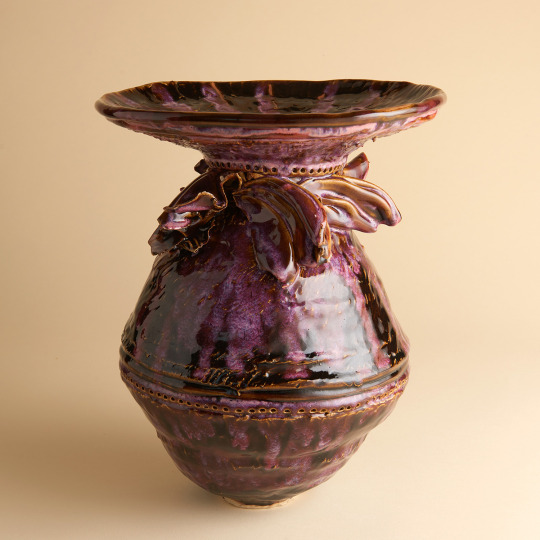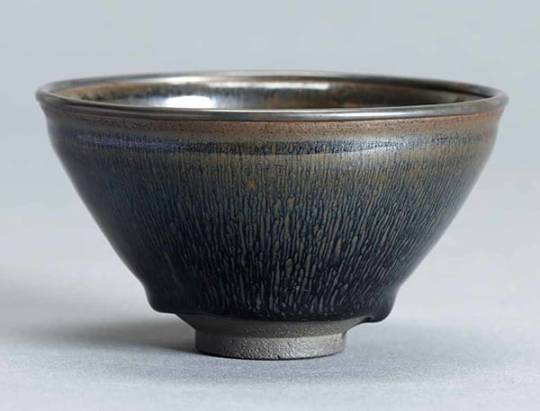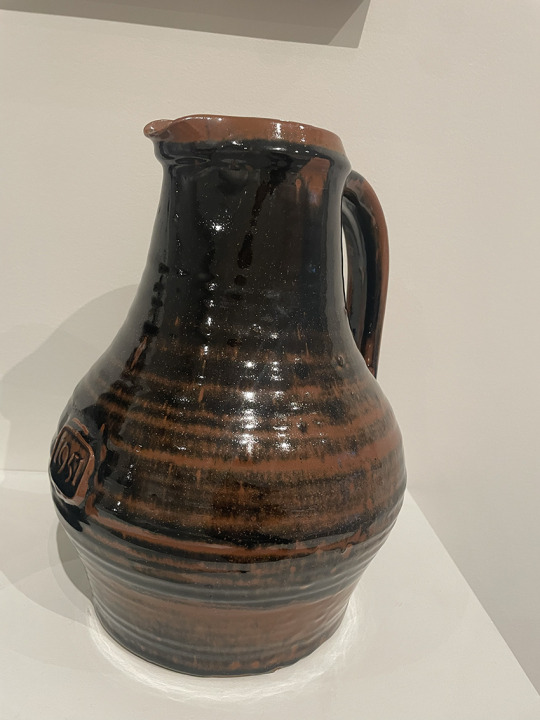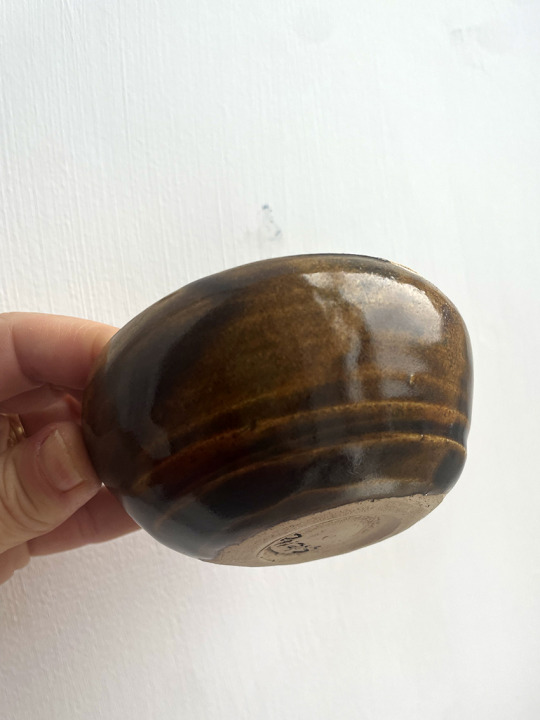#arthousewakefield
Text
Adventures with Tenmoku
Tenmoku or Tenmokuyu or even Temoku, is a general term used for a glossy, deep brown iron glaze in ceramics and pottery.

I was introduced to Tenmoku from my early days working with clay, over two years now. Initially I didn't really like it, finding it sometimes too dark, but not quite black, either. The endearing power of the glaze, however, is that it has a depth and range of browns. Depending on how it is applied, it varies from dark brown, to warmer brown, to translucent even when applied thinly. I have used it on many occasions, especially for my coil pots.
Below you can see the results when I used it for my large coil pot, Rosey, (seen below) combined with a commercial raspberry glaze (Mayco). The result was a range of dark purples and browns, that give depth to the surface of the pot. I particularly like the glossy finish as this reflects light and adds an element of sophistication to my work.

The history: Tenmoku glazes originate from Japan, where they have a very long history. Popularised by tea bowls, initially, Tenmoku referred to both the shape of the tea bowl and the dark, glossy glaze that covered these bowls.
Introduced by Japanese monks and priests that came back from China, after visiting the sacred Tianmu Mountain, in the Heian Period (794-1185). At this time, tea drinking was reserved for the rich and the Emperor. With the rise of the popularity of tea drinking, however, by the middle ages (Kamakura and Muromachi periods) so too, the popularity of the tenmoku teabowls spread amongst the larger population.
The example below is typical example of the tea bowl, known for its distinct dark brown colour. This one is from the Kyoto National Museum,

In England, it was introduced in the 1950's by Bernard Leach and the Leach Pottery in St.Ives, Cornwall, after the visit of Japanese master potter Shoji Hamada, at St. Ives. It has been widely used since in function ware, especially coffee mugs, jugs and other tableware.
Below, you can see two examples of Tenmoku, the one on the left, is the Tenmoku tea bowl, by master Shoji Hamada, in the collection of Tate Museum, whilst the one on the left, is currently on display at the exhibition, The Art of the Potter: Ceramics and Sculpture 1930's to now, at the Hepworth, Wakefield and belongs to the potter David Leach, of the Leach family.


It has been criticised often for being old fashioned, however what draws me to this glaze its history and notoriety as well as the fact that it has withstood the test of time and remains, remarkably, a staple glaze for many pottery studios today.
During my residency at Rochester Square Arts, over the summer and autumn this year, I sought to make my own batch of Tenmoku.
Not knowing what I would get myself into, I began my adventures with iron oxides. Having only done a very short course in making my own custom glazes, equipped with raw materials like iron oxide, manganese oxide and fluxes, like nepheline syenite, cornish stone and potash feldspar, I began my very first tests.
The first recipe I tested was of the iconic Bernard Leach tenmoku. This did give some interesting results but I was disappointed, as the application of the glaze was uneven in areas and didn't yield the deep, rich browns I was hoping for.


The second recipe I tried, was from the contemporary Florian Gadsby, the ceramicist based in North London. It comes complete with a YouTube video, for fool-proof testing. 😀
I was drawn to the simple three ingredients of this recipe: definitely a lot of Cornish Stone (85%) Whiting (15%) and quite a bit of the Red Iron Oxide (16%). This one, finally, gave me the sleek, mirror-like surface of the finish I was hoping for. However, for my taste, the 16% red iron oxide is too much. Below, you can see my test tile results of this on B17 stoneware clay and Porcelain.
I found this one way too dark, so I made another test batch, with a recipe from The Glaze Book, by Stephen Murphitt.
FInally, as a last tester I tried my own former teacher's Tenmoku, Chris Crawford, at Sunken Studios.
I am not sure I got the mix quite right here as there are some delicate balances, and this one contains a lot more ingredients than the above. In the classic Bernard Leach, Potash Feldspar is used as the flux, whilst here I do like the substitution of Potash with Nepheline Syenite.
The verdict? I really like the glossy, mirror like finish that the Gadsby's Cornish Stone recipe gives. It also avoid the pin-holing that can occur with Tenmoku recipes.
I think I will settle for this one, with the Iron Oxide at 12% instead of 16%.



Further links and reading:
#ceramics#glazing#contemporary art#fine art#women in art#custom made#kyoto#japan#bernardleach#tenmoku#artscouncilfunding#dycpfunding#arthousewakefield
2 notes
·
View notes
Photo

#fridayvibes #fridayart to #portrature #face #raw #otsiderart #outsiderartgalleries #nftgalleries #nftcollectors #nftportrait. #digtialpainting #flowerseastgallery #jennifergilbert #arthousewakefield #rawcollection #dyslxicart #SLWA #outsiderartgalleries #vaa https://www.instagram.com/p/CSgbWjqMkLo/?utm_medium=tumblr
#fridayvibes#fridayart#portrature#face#raw#otsiderart#outsiderartgalleries#nftgalleries#nftcollectors#nftportrait#digtialpainting#flowerseastgallery#jennifergilbert#arthousewakefield#rawcollection#dyslxicart#slwa#vaa
0 notes
Video
vimeo
Arty folk, you may enjoy this video, filmed a few months ago. Home & Away was in collaboration with the Art House Wakefield and support by Art Council England and Art House Wakefield.
0 notes